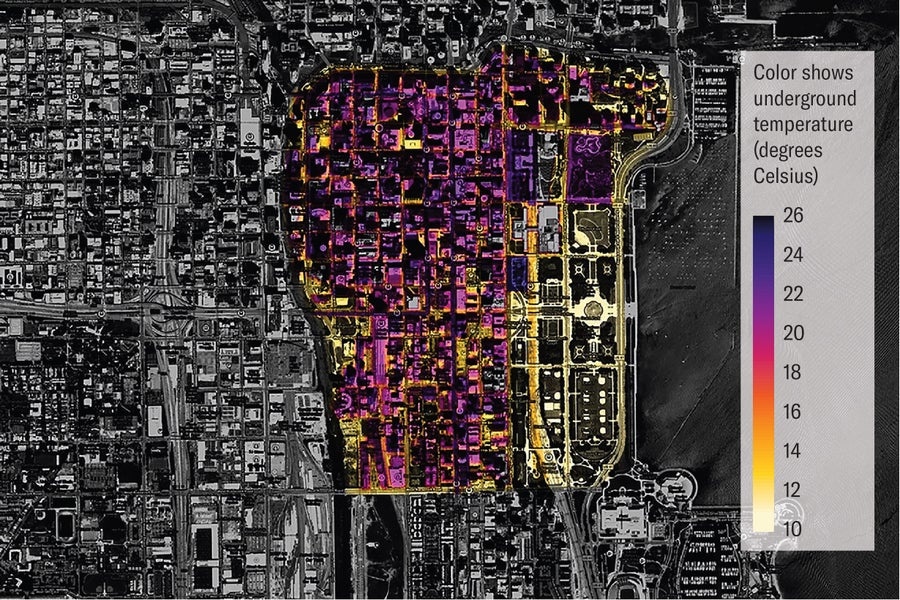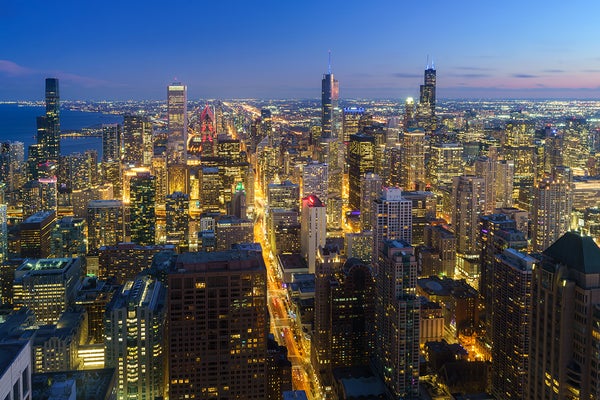The streets, sidewalks and roofs of cities all absorb heat during the day, making some urban areas up to six degrees Fahrenheit hotter than rural ones during the day—and 22 degrees F hotter at night. These “urban heat islands” can also develop underground as the city heat diffuses downward, beneath the surface. And basements, subway tunnels and other subterranean infrastructure also constantly bleed heat into the surrounding earth, creating hotspots. Now that underground heat is building up as the planet warms.
According to a new study of downtown Chicago, underground hotspots may threaten the very same structures that emit the heat in the first place. Such temperature changes make the ground around them expand and contract enough to cause potential damage. “Without [anyone] realizing it, the city of Chicago’s downtown was deforming,” says the study’s author Alessandro F. Rotta Loria, a civil and environmental engineer at Northwestern University.
The findings, published on July 11 in Communications Engineering, expose a “silent hazard” to civil infrastructure in cities with softer ground—especially those near water—Rotta Loria says. “There might have been structural issues caused by this underground climate change that happened, and we didn’t even realize,” he adds. While not an immediate or direct danger to human lives, this previously unknown effect highlights the impacts of a lesser-known component of climate change.
On supporting science journalism
If you're enjoying this article, consider supporting our award-winning journalism by subscribing. By purchasing a subscription you are helping to ensure the future of impactful stories about the discoveries and ideas shaping our world today.
“For a lot of things in the subsurface, it’s kind of ‘out of sight, out of mind,’” says Grant Ferguson, an engineering geologist at the University of Saskatchewan, who was not involved in the new study. The underground world teems with life, however. It is home to animals that have adapted to subterranean living such as worms, snails, insects, crustaceans and salamanders. These creatures are used to “very static conditions,” says Peter Bayer, a geoscientist at the Martin Luther University Halle-Wittenberg in Germany, who was also not involved in the paper. Aboveground temperatures often swing wildly throughout the year, but the subsurface remains around the yearly average temperature, he explains. In Chicago, that’s about 52 degrees F.

Colors show underground temperatures in Chicago’s Loop district. Credit: Alessandro F. Rotta Loria (temperature data); OpenStreetMap (base map) (CC BY-SA 2.0)
The subsurface has “a memory that air temperatures don’t have,” Ferguson says. As these stable temperatures rise because of climate change and underground urban development, scientists such as Ferguson and Bayer are keeping tabs on the potential implications for underground ecosystems. For example, if groundwater gets too warm, it could kill or drive away animals, trigger chemical changes in the water and become a breeding ground for microbes.
But the question of how underground hotspots could affect urban infrastructure has gone largely unstudied. Because materials expand and contract with temperature change, Rotta Loria suspected that heat seeping from basements and tunnels could be contributing to wear and tear on various structures.
He collected three years of temperature data from more than 150 sensors installed in basements, train tunnels and parking garages underneath Chicago’s downtown Loop district. For comparison, sensors were also installed in the ground beneath Grant Park, which is located in the Loop, along the shore of Lake Michigan.
Chicago’s overall ground temperatures are rising by 0.25 degree F each year, with readings in specific underground locations as much as 27 degrees F hotter than undisturbed ground. Temperatures beneath Loop buildings are often 18 degrees F hotter than those beneath Grant Park.* To understand how this large difference has affected the physical properties of the ground, Rotta Loria used a computer model to simulate the underground environment from the 1950s to now—and then to predict how conditions will change from now until 2050.
He found that by the middle of this century, some areas under the Loop may heave upward by as much as 12 millimeters (0.47 inch) or settle by as much as eight millimeters (0.31 inch), depending on the soil makeup of the area involved. Though these may sound like small displacements, Rotta Loria says they could cause cracks in the foundations and walls of some buildings. This could lead to water damage or cause buildings to tilt. Over recent decades, this hidden factor could have contributed to some of the ongoing challenges and costs of maintaining these structures, he says.
Kathrin Menberg, a geoscientist at the Karlsruhe Institute of Technology in Germany, who was not involved in Rotta Loria’s study, says these displacement predictions are orders of magnitude higher than what she would have guessed and could be linked to Chicago’s soft, clay-heavy soils. “Clay material is particularly sensitive,” she says. “It would be a big issue in all cities worldwide that are built on such material.” This would include many cities near oceans and rivers—London, for example, is built on a layer of clay. In contrast, cities built largely on harder rocks (such as New York City), would not be as impacted by this effect, Ferguson says.
Similar to climate change above the surface, these underground changes occur over long periods of time. “These effects took decades, a century, to develop,” Ferguson says, adding that elevated underground temperatures would likewise take a long time to dissipate on their own. “We could basically turn everything off, and it’s going to persist there, the temperature signal, for quite a while.”
But Ferguson and the other researchers interviewed for this story all say this wasted energy could also be reharnessed, presenting an opportunity to both cool the subsurface and save on energy costs. Subway tunnels and basements could be retrofitted with geothermal technologies to recapture the heat. For example, water pipes could be installed to run through underground hotspots and pick up some of the thermal energy. While that energy wouldn’t be hot enough to turn the water into steam and create electricity, it could still be used to heat buildings and other civil infrastructure. This approach may or may not be worth the effort because it would require a high up-front cost and, in the case of the Loop district, may add up to less than 1 percent of local energy demand.
Still, this calculus could be altered as aboveground climate change continues to amplify underground warming. In a warming world, buildings will require more electricity to stay cool, generating more wasted energy in the form of heat. However slowly, this heat will accumulate beneath our feet. “It’s like climate change,” Rotta Loria says. “It’s happening. Maybe we don’t see it always, but it’s happening.”
*Editor’s Note (7/11/23): This sentence was edited after posting to correct the description of how hot temperatures below Chicago’s Loop district often are, compared with those below Grant Park.
A version of this article with the title “Weather Underground” was adapted for inclusion in the October 2023 issue of Scientific American.
